The quartz vs granite debate for kitchen countertops has taken an interesting turn lately. The National Kitchen & Bath Association’s 2024 trends report reveals some striking numbers – 73% of industry professionals expect quartz to grow in popularity, while granite lags behind at 32%.
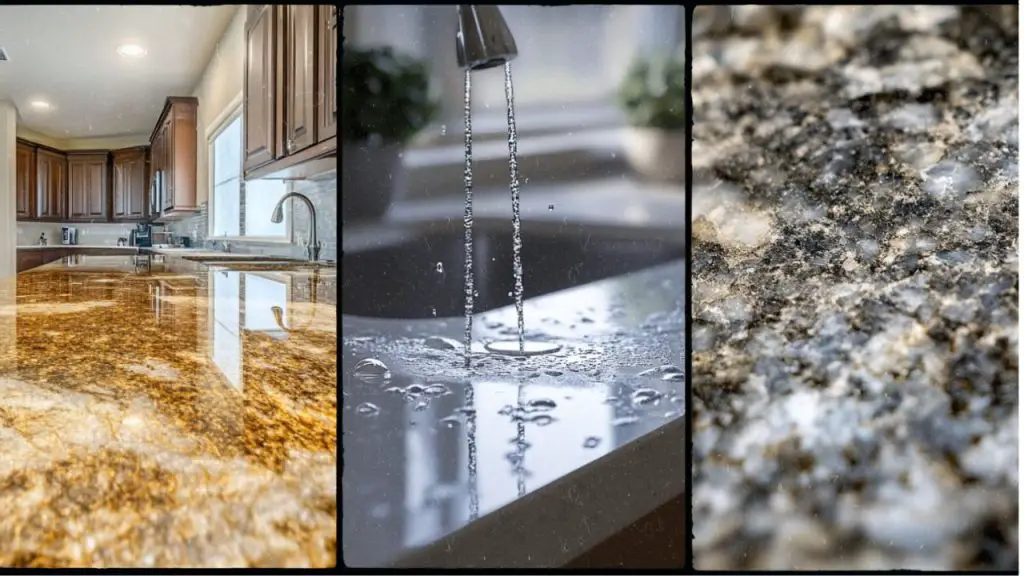
Granite Vs. Quartz
Your kitchen renovation or new home construction needs careful thought about countertop materials. These two options bring unique benefits to the table. Granite showcases natural, unique patterns with colors ranging from earthy to vibrant tones. Quartz countertops offer consistency and easy maintenance thanks to their engineered structure.
The price difference between these materials can affect your budget substantially. Granite’s cost ranges from $50 to $200 per square foot, while quartz typically runs between $70 to $100 per square foot. Understanding the key differences between quartz and granite countertops will help you choose the perfect option for your kitchen.
Material Composition and Appearance
Let’s dive into what makes quartz and granite different by looking at their basic makeup. The way these materials are made explains why they look and perform differently.
Quartz vs Granite: Engineered vs Natural Stone
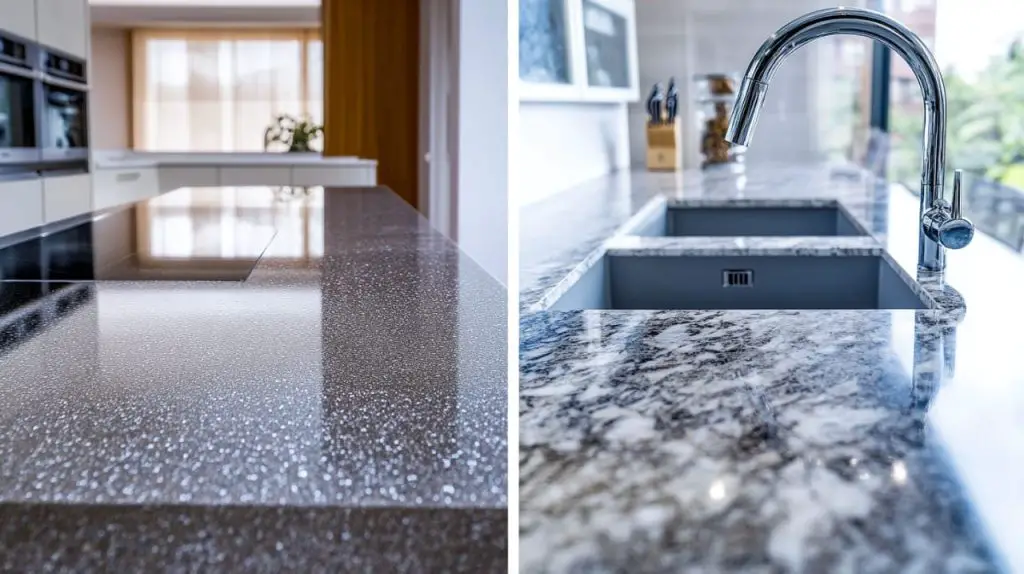
You’ll find granite countertops are 100% natural stone that comes straight from the earth. Workers cut it into slabs and polish it before installation. Quartz countertops are engineered products that combine 93% crushed natural quartz crystals with 7% polymer resins and pigments. The ratio sounds straightforward, but it’s based on weight. The finished quartz product actually has 30-40% resin.
| Characteristic | Quartz | Granite |
|---|---|---|
| Composition | 93% crushed quartz, 7% resin (by weight) | 100% natural stone |
| Formation | Manufactured with stone byproducts | Quarried from earth |
| Environmental Impact | Uses recycled materials, reducing waste | Requires mining from earth’s crust |
| Core Material | Primarily natural minerals with binding agents | Completely natural stone |
Visual Appeal: Uniform Patterns vs Unique Slabs
These materials look quite different from each other. Granite gives you unique patterns – each slab is a bit different in its mineral pattern and color. This means your countertop will be one-of-a-kind. Quartz looks more uniform because it’s engineered.
Granite shows off dramatic veining and depth that quartz makers try to copy but can’t quite match. People love granite because it has natural uniqueness and deep colors that just can’t be made artificially.
Color Options: Custom Shades vs Earthy Tones
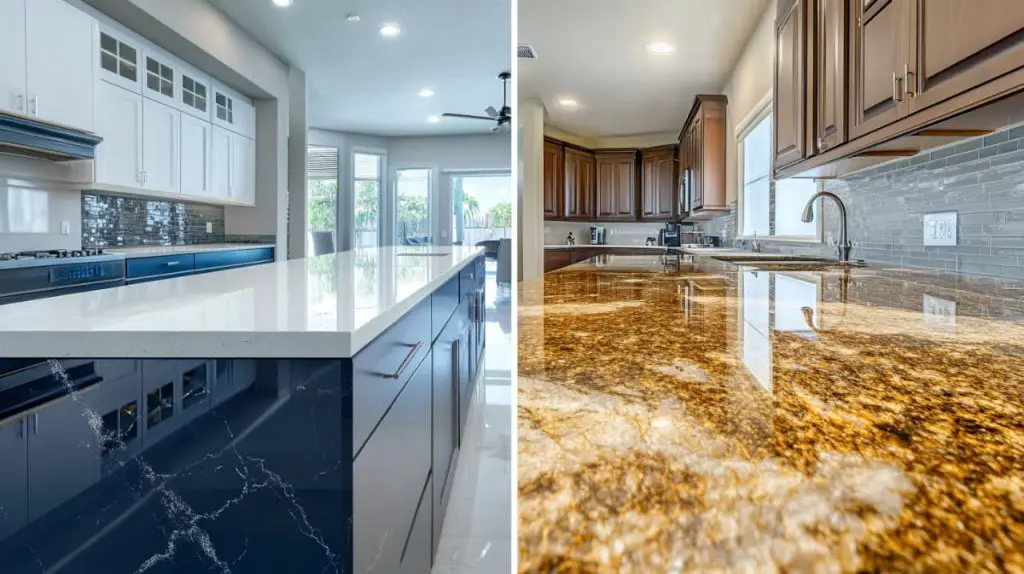
Granite comes in earthy colors like black, brown, tan, white, and sometimes blue or green. Each stone adds its own character to your space with natural variations.
Quartz gives you more color choices. Manufacturers can create almost any color or pattern you want. You can get anything from marble-look finishes to solid colors and modern concrete styles. This makes quartz a great fit for any design style, and it’s especially good at looking like marble without marble’s upkeep hassles.
Your choice between quartz and granite might depend on whether you want the consistent, customizable look of quartz or the unique, natural beauty that only real stone can give you.
Durability and Heat Resistance in Daily Use
Real-world kitchen performance often helps homeowners decide between quartz and granite countertops.
Scratch Resistance: Resin-Bonded vs Solid Stone
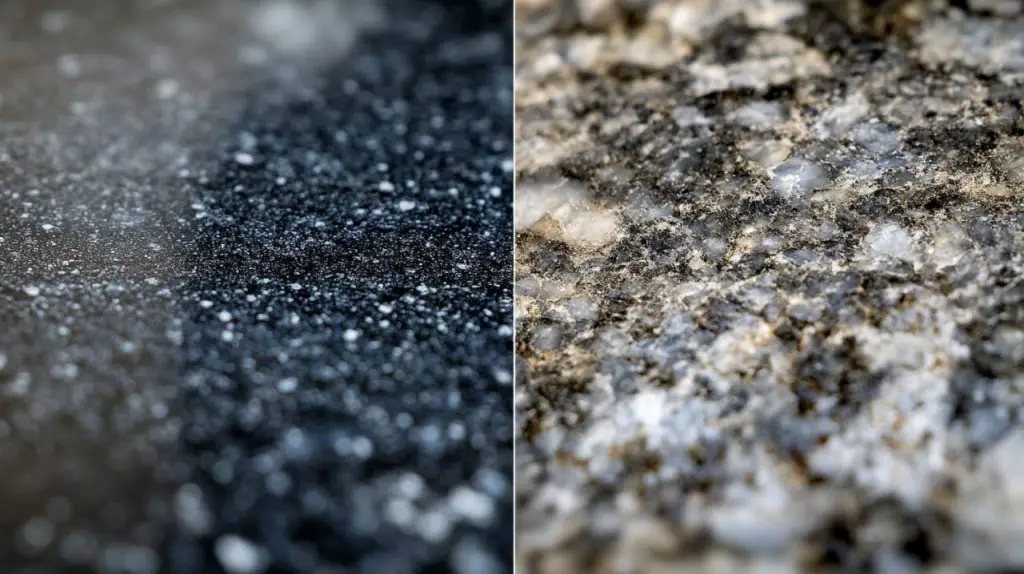
Kitchen countertops face daily challenges during food preparation. Quartz scores 7 on the Mohs hardness scale, while granite rates between 6-6.5. Both materials resist kitchen knife scratches remarkably well, despite this slight difference.
Comparison of Scratch Resistance:
| Feature | Quartz | Granite |
|---|---|---|
| Hardness Rating | 7 on Mohs scale | 6-6.5 on Mohs scale |
| Composition Impact | Engineered with 93% quartz, 7% resin | Natural stone with varying mineral density |
| Repair Options | Polishing compound with resin | Steel wool followed by resealing |
Heat Tolerance: 300°F Limit vs Direct Pan Placement
Heat resistance shows a significant difference between these materials. Quartz can handle temperatures up to 300°F, while granite stands strong at temperatures reaching 1,200°F.
Heat Resistance Comparison:
| Feature | Quartz | Granite |
|---|---|---|
| Maximum Safe Temperature | 300°F [121] | 1,200°F [132] |
| Risk from Hot Cookware | Discoloration, cracking, burn marks | Minimal damage from normal kitchen use |
| Required Protection | Trivets or hot pads necessary | Can handle direct pan placement |
Crack and Chip Resistance: Flexibility vs Natural Flaws
Quartz resists chips better because of its resin content. This engineered material’s flexibility reduces the chance of chipping from impacts.
Durability Against Impact:
| Feature | Quartz | Granite |
|---|---|---|
| Resistance to Chipping | More flexible, less likely to chip | Can chip from heavy impacts |
| Repair Difficulty | More challenging to repair damage | Easier to repair chips and cracks |
| Consistent Durability | Uniform throughout material | May have natural fissures or weak points |
Your cooking habits and lifestyle should guide your final choice, since both materials handle daily use well but show different strengths in heat resistance and impact durability.
Maintenance and Hygiene Factors
Kitchen countertops need more than just good looks and durability. Your satisfaction often depends on how much work they need over time. The way you care for quartz versus granite can make a big difference when choosing between them.
Sealing Needs: Annual for Granite vs None for Quartz
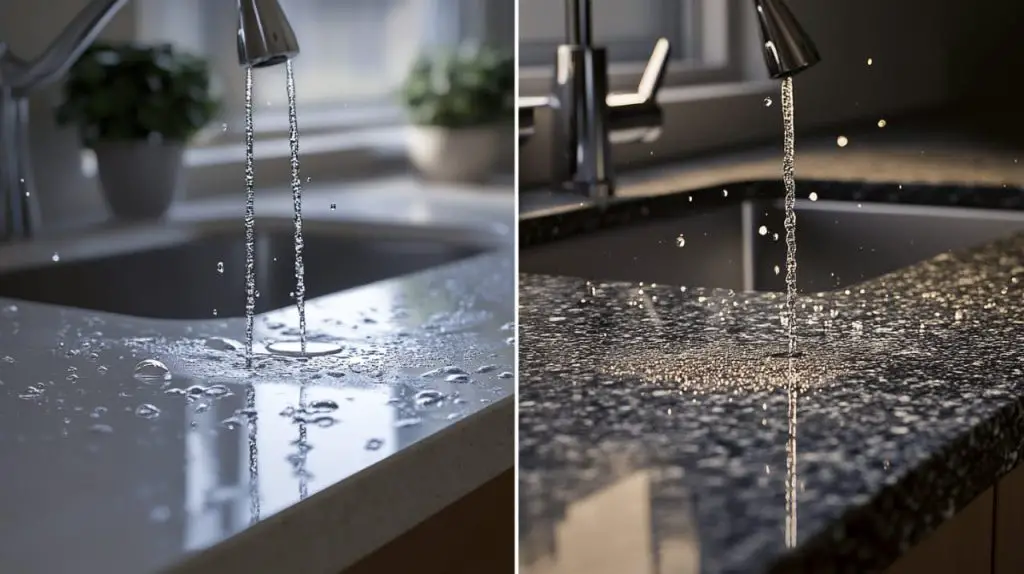
Granite’s porous surface needs regular upkeep to stay protected. Most granite countertops need sealing right after installation and again every 6-12 months to prevent stains and damage. A quick water test shows when it’s time to reseal – if water soaks in instead of forming beads on top, you’ll need to reseal.
Quartz makes life easier by eliminating this task completely. The way it’s made creates a surface that never needs sealing. The resin used in quartz keeps liquids from soaking in, which gives it built-in protection.
Maintenance Comparison:
| Factor | Granite | Quartz |
|---|---|---|
| Sealing Frequency | Every 6-12 months | Never |
| Maintenance Cost | Annual expense for sealant | No ongoing cost |
| Testing Method | Water absorption test | Not applicable |
Stain Resistance: Porous vs Non-Porous Surfaces
Porosity makes a huge difference in how these materials resist stains. Granite’s tiny pores soak up spilled liquids, which might leave permanent marks if you don’t clean them quickly or seal the surface properly. Even sealed granite can get damaged by wine or citrus juice.
Quartz works differently because nothing soaks in. Spills stay on top where you can easily wipe them away, so stains rarely happen.
Bacteria Resistance: Antimicrobial Additives vs Natural Stone
Quartz’s non-porous surface gives it an edge in fighting bacteria. Microorganisms can’t get inside the material, which naturally stops them from growing. Many quartz products come with special antimicrobial ingredients that kill bacteria before they multiply.
Granite actually handles bacteria better than you might expect. With proper sealing and cleaning, it fights bacteria well – one study showed granite killed e-coli nine times better than stainless steel after normal cleaning.
Families who want the most hygienic kitchen surfaces usually prefer quartz’s non-porous surface. Both materials can keep your kitchen clean and safe if you take care of them properly.
Quartz vs Granite Cost and Installation
Kitchen countertop budget planning should factor in material costs and installation needs. A clear understanding of the total investment will help you choose between quartz and granite.
Material Cost: $50–$200/sq ft Range
Quality, color, and source drive the price differences between quartz and granite. Most homeowners pay within these ranges:
Quartz vs Granite Cost Comparison:
| Material | Cost Per Square Foot | Average Total (30-40 sq ft) |
|---|---|---|
| Quartz | $50-$200 installed | Average cost per square foot installed |
| Granite | 85-$200+ | Average cost per square foot installed |
Premium quartz brands set different price points based on design complexity and reputation. Cambria costs $60-$125, Caesarstone runs $50-$100, and Silestone ranges from $60-$140.
Natural variation and rarity affect granite’s price more significantly. Common granite types cost less than exotic options with unique colors or patterns.
Installation Complexity: Weight and Fabrication Needs
These materials aren’t suitable for DIY installation due to their weight. Quartz weighs 20-25 pounds per square foot, while granite is lighter at 18-20 pounds. A modest 36-inch countertop can weigh up to 100 pounds.
The installation process involves:
- Creating precise templates of your countertop layout
- Cutting slabs with specialized equipment
- Fabricating edges and polishing surfaces
- Ensuring cabinets can support the substantial weight
- Securing countertops with silicone adhesive
Professional installation costs range from $35-$75 per square foot for granite and $30-$75 for quartz. This investment will give a solid structure and proper seaming.
Warranty and Brand Differences
Quartz manufacturers’ warranties last longer than granite suppliers’. Leading quartz brands provide:
- 15-25 year limited warranties
- Some offer lifetime limited warranties
- Coverage for manufacturing defects only
Granite rarely comes with complete warranties since it’s a natural, unbranded product. Available warranties usually cover fabrication defects rather than the stone itself.
Most warranties don’t include damage from improper use, excessive heat, or outdoor installation. They also exclude removal or reinstallation costs if replacement becomes needed.
Comparison Table
1. Properties & Composition
| Feature | Quartz | Granite |
|---|---|---|
| Composition | 93% crushed quartz + 7% resin (by weight) | 100% natural stone |
| Material Type | Engineered stone | Natural stone |
| Formation | Manufactured with stone byproducts | Quarried from earth |
| Environmental Effect | Uses recycled materials | Requires mining |
2. Look & Style
| Feature | Quartz | Granite |
|---|---|---|
| Pattern Consistency | Uniform, consistent patterns | Unique, one-of-a-kind patterns |
| Color Options | Wide range, customizable colors | Natural earthy tones (black, brown, tan, white) |
| Veining | Manufactured veining | Natural dramatic veining |
| Design Flexibility | Can mimic materials of all types | Natural stone appearance only |
3. Strength & Performance
| Feature | Quartz | Granite |
|---|---|---|
| Hardness Rating | 7 on Mohs scale | 6-6.5 on Mohs scale |
| Heat Resistance | Up to 300°F | Up to 1,200°F |
| Chip Resistance | More flexible, nowhere near as likely to chip | Can chip from heavy impacts |
| Repair Difficulty | More challenging to repair | Easier to repair chips and cracks |
4. Care & Upkeep
| Feature | Quartz | Granite |
|---|---|---|
| Sealing Requirements | Never needs sealing | Every 6-12 months |
| Stain Resistance | Non-porous, highly resistant | Requires sealing to protect |
| Bacterial Resistance | Natural resistance + antimicrobial additives | Good when properly sealed |
| Daily Maintenance | Simple cleaning only | Regular cleaning + periodic sealing |
5. Price & Installation
| Feature | Quartz | Granite |
|---|---|---|
| Cost Range (per sq ft) | $50-$200 installed | $40-$150 installed |
| Average Total Cost (30-40 sq ft) | $1,500-$8,000 | $2,400-$6,000 |
| Weight (per sq ft) | 20-25 pounds | 18-20 pounds |
| Installation Cost (per sq ft) | $30-$75 | $35-$75 |
| Warranty | 15-25 year limited warranties | Limited/rare warranty coverage |
Conclusion
Your choice between quartz and granite countertops ends up depending on your specific needs, lifestyle, and priorities. Both materials are worthy contenders that bring distinct advantages to your kitchen.
Granite’s unique natural patterns and superior heat resistance up to 1,200°F make it stand out, though it needs annual sealing maintenance. This natural stone adds unmatched character to your kitchen, especially when you have a taste for one-of-a-kind esthetics.
Quartz countertops shine in practical benefits. The non-porous surface needs no sealing and resists stains better. Despite its 300°F heat tolerance limit, quartz provides consistent patterns and wider color options that enhance modern kitchen designs.
Think over these key decision factors:
| Factor | Choose Granite If You… | Choose Quartz If You… |
|---|---|---|
| Maintenance | Don’t mind annual sealing | Prefer minimal upkeep |
| Cooking Style | Frequently use hot cookware | Typically use trivets |
| Esthetics | Value natural variations | Prefer consistent patterns |
| Budget | Want lower original cost | Plan for long-term value |
Both granite and quartz will serve as durable, attractive additions to your kitchen space. The right choice should arrange with your cooking habits, maintenance priorities, and design vision while fitting your budget comfortably.
FAQs
Q1. Can quartz and granite be installed as DIY projects? No, neither material is suitable for DIY installation due to their weight. Quartz weighs 20-25 pounds per square foot, and granite weighs 18-20 pounds per square foot. Both require professional installation with specialized equipment for cutting, fabrication, and proper seaming.
Q2. Which countertop material is more heat resistant? Granite has superior heat resistance, withstanding temperatures up to 1,200°F, while quartz can only handle temperatures up to 300°F. This means hot pots and pans can be placed directly on granite, but trivets or hot pads are necessary for quartz.
Q3. Do granite countertops require more maintenance than quartz? Yes. Granite countertops are porous and require sealing every 6-12 months to prevent stains and damage. Quartz countertops are non-porous and never need sealing, making them lower maintenance.
Q4. Which material is more resistant to stains? Quartz is more stain-resistant because its non-porous surface prevents liquids from soaking in. Even properly sealed granite can be damaged by wine or citrus juice due to its naturally porous structure.
Q5. How do the costs of granite and quartz compare? Granite typically costs between $40-$150 per square foot installed, while quartz ranges from $50-$200 per square foot installed. The total average cost for a kitchen (30-40 square feet) is $2,400-$6,000 for granite and $1,500-$8,000 for quartz.
